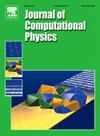An augmented shadowing algorithm for calculating the sensitivity of time-average quantities of chaotic systems
IF 3.8
2区 物理与天体物理
Q2 COMPUTER SCIENCE, INTERDISCIPLINARY APPLICATIONS
引用次数: 0
Abstract
We apply the non-intrusive least-squares shadowing (NILSS) method to a newly proposed augmented tangent system in order to calculate the sensitivity of time-average quantities of chaotic dynamical systems to parameter variations. The original tangent system is augmented with an additional equation that acts as a low-pass filter, leaving low frequencies unaffected while filtering out high frequencies. A linear damping term is also added to the original tangent system; the term is activated at high frequencies but vanishes at low frequencies. The method introduces two new parameters, the damping coefficient and the time-scale of the filter. Their values can be estimated from the properties of the dynamical system. We evaluate the performance of the proposed algorithm in the Kuramoto–Sivashinsky equation and the Kolmogorov flow system. The number of non-negative Lyapunov exponents (NNLEs) of the augmented system is generally smaller than that of the original system, and this accelerates the sensitivity calculations. Comparisons with the standard NILSS demonstrate the accuracy of the method at a reduced computational cost. The proposed algorithm is more scalable compared to existing approaches and can be applied to sensitivity analysis as well as optimisation and control of complex, large-scale dynamical systems, including turbulent flows.
一种计算混沌系统时间平均量灵敏度的增广阴影算法
为了计算混沌动力系统的时间平均量对参数变化的敏感性,我们将非侵入式最小二乘阴影(NILSS)方法应用于新提出的增广切线系统。原始切线系统增加了一个额外的方程,作为一个低通滤波器,使低频不受影响,同时过滤掉高频。在原正切系统中加入线性阻尼项;这个词在高频时被激活,但在低频时消失。该方法引入了两个新参数,即滤波器的阻尼系数和时间尺度。它们的值可以由动力系统的性质来估计。我们在Kuramoto-Sivashinsky方程和Kolmogorov流系统中评估了该算法的性能。增广系统的非负李雅普诺夫指数(NNLEs)数通常小于原系统,这加快了灵敏度计算。与标准NILSS的比较证明了该方法在减少计算成本的情况下的准确性。与现有方法相比,所提出的算法更具可扩展性,可以应用于敏感性分析以及复杂的大规模动态系统(包括湍流)的优化和控制。
本文章由计算机程序翻译,如有差异,请以英文原文为准。
求助全文
约1分钟内获得全文
求助全文
来源期刊

Journal of Computational Physics
物理-计算机:跨学科应用
CiteScore
7.60
自引率
14.60%
发文量
763
审稿时长
5.8 months
期刊介绍:
Journal of Computational Physics thoroughly treats the computational aspects of physical problems, presenting techniques for the numerical solution of mathematical equations arising in all areas of physics. The journal seeks to emphasize methods that cross disciplinary boundaries.
The Journal of Computational Physics also publishes short notes of 4 pages or less (including figures, tables, and references but excluding title pages). Letters to the Editor commenting on articles already published in this Journal will also be considered. Neither notes nor letters should have an abstract.
 求助内容:
求助内容: 应助结果提醒方式:
应助结果提醒方式:


